December 20, 2017
Written by Steve Mellon
Reporting
Steve Mellon, Stephanie Strasburg,and Rich Lord
A car rolled slowly down a strip of cracked gray asphalt known as Santron Avenue, then turned slightly and parked in front of a modest yellow brick house in Pittsburgh's Carrick neighborhood. A tiny girl bounded from the back seat. Moments later, a slender man with thinning white hair climbed out of the driver’s seat and joined the girl on the sidewalk.
Glenn Jeffries was sitting on concrete steps leading to his home across the street, in Santron Avenue’s 100 block. His thoughts were focused on the dark aspects of his life: the sickness that would soon creep up on him, lost opportunities, lost family. “My mom OD’d years ago,” he was saying. “I was in jail. She was eating the gel out of fentanyl patches.”
Then he saw the girl. Her blond hair glowed in the brilliant late-July sun.
“Carly,” Glenn called out.
The girl looked up. Glenn waved.
“That’s my daughter,” Glenn said. She’s 6. His other daughter, Cathy, is 8. The girls live with the white-haired man, whose name is Russell.
Glenn’s 41 years of life have etched deep creases in his forehead. Past news stories have, at various times, described him as a murderer and a thief and a hero. He has served more than a dozen years in prison. His neighbors view him as an addict. But in this moment Glenn became a dreamer. He envisioned his daughters back home, living with him and his partner, Autumn Rudolph.
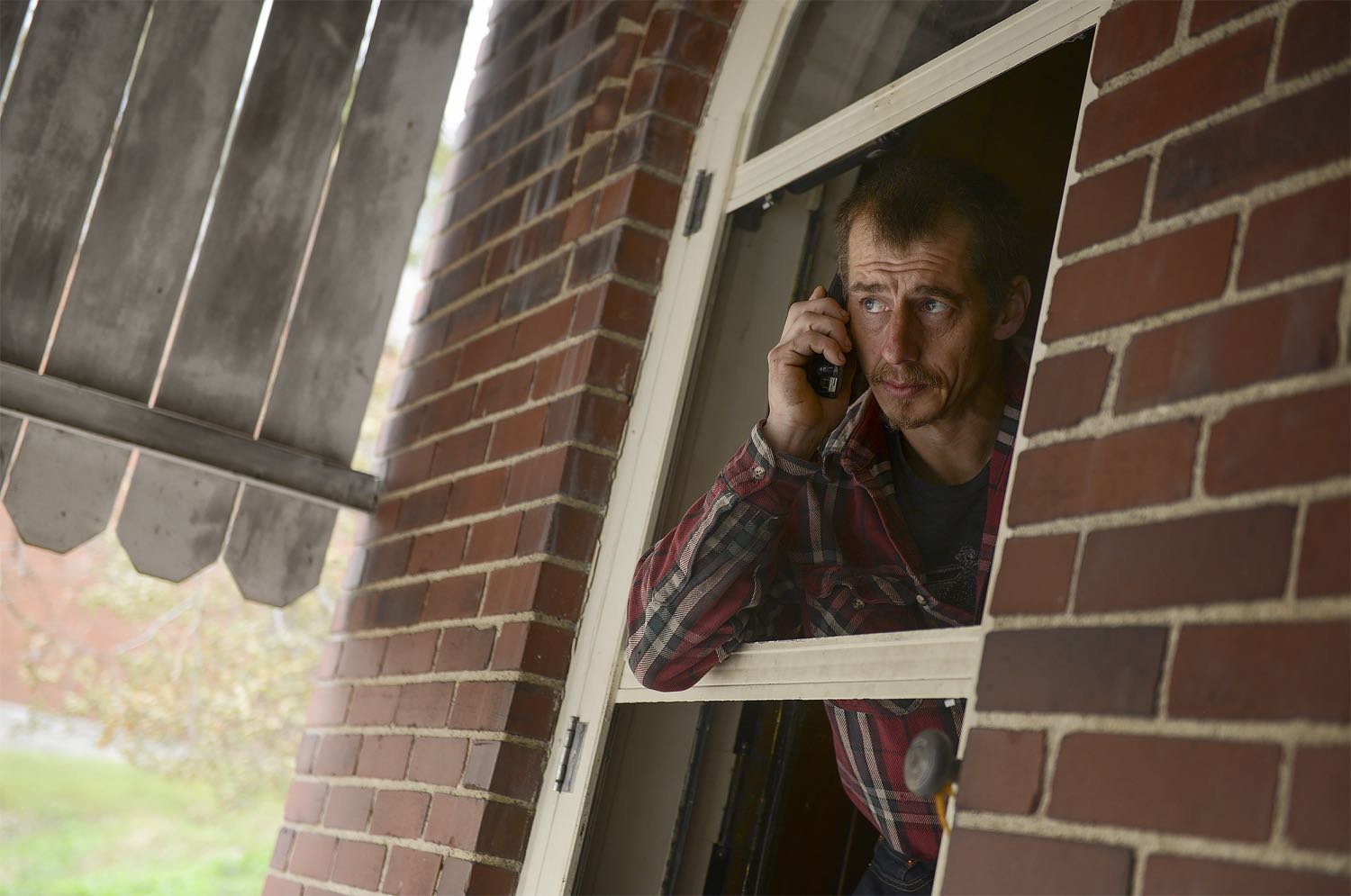
Glenn Jeffries said he and his partner Autumn Rudolph wanted to break free of an addiction to opiates so they could get their two daughters back. (Steve Mellon/Post-Gazette)
He yearned to move his family to a place near Tionesta Creek, deep in the Allegheny National Forest, to the house Autumn called home when she was a child. It’s a safe and isolated place, he said. There’s no dope, no dealers. He and Autumn could finally get clean and stay clean. No more bleary-eyed trips to see the dope man in early morning, no more getting stopped by police with bags of heroin in your lap, no more terrifying moments when you wake from your own overdose to see your partner unconscious and not breathing and so you pound on her chest to keep death away.
Glenn and Autumn and Cathy and Carly could once again be family.
Some who know Glenn roll their eyes when they hear him talk like this. He’s a hopeless case, they say. He and Autumn will never quit, never get clean. It’s just a matter of time, they fear, before one or both of them end up dead. But on this day, Glenn was confident. “We called rehab today,” he said.
His daughter disappeared into Russell’s house. Glenn remained on the steps of his home, looking out over a street that would, in the days and weeks ahead, be haunted by addiction and loss.
Riding
road
Steve Mellon, Rich Lord and Stephanie Strasburg of the Pittsburgh Post-Gazette spent five months reporting on and photographing the impact of the opioid drug crisis in the city’s hardest-hit neighborhood of Carrick. This is the second part of their report. The first, Riding OD Road, was published on Nov. 2.
Medical examiner employees wheel Jenn Dolton’s body to a waiting van. (Steve Mellon/Post-Gazette)
Santron Avenue, approximately 600 feet long, follows a bowl-shaped landscape in working-class Carrick, the Pittsburgh neighborhood most ravaged by drugs. Glenn’s home is one of three ordinary houses sitting side by side at the street’s lowest point. In 2017, the potent mix of heroin and fentanyl -- called “dope” by those caught in its orbit -- exerted such a powerful and destructive pull on this small section of Santron that it warped the lives of all who spent time there.
In April, a high school student’s quick action in the middle house stopped dope from destroying her small family. At the height of summer, the house on the left became the endpoint of a reckless ride that nearly proved fatal. And on a drizzly August afternoon, dope ushered death onto the barren back porch of the house on the right, hurling one family into a chasm of pain. As fall approached, a sleepless and grieving father drove along Santron after midnight and posed questions no one would, or could, answer.
Jenn Dolton, 35, walked out of the Allegheny County Jail on a cloudy Tuesday in August. Her marriage was a wreck, her kids were gone. She was broke. Her house on West Woodford Avenue, a few blocks from Santron Avenue, was an uninhabitable hulk with no heat, no water and no electricity.
At least now her body was cleansed of the dope that had ruined the past five or six years of her life. Jenn was using 50 bags of heroin a day in early 2017. She told a counselor she’d recently tried to kill herself by overdose.
So Jenn spent February and early March in a drug treatment program in Williamsport, Pa., then moved into a rehab facility in Pittsburgh. She gained weight and talked about selling her house.
In May, she turned herself over to authorities and began serving jail time on drug charges. Her family believes she wanted to clear up the charges and get a fresh start.
Jail was tough. “I really hate my life,” she wrote to her father on June 6, one day after her two children had celebrated birthdays.
Jenn’s letter is a six-page stream of regret, rage, pain and self-pity.
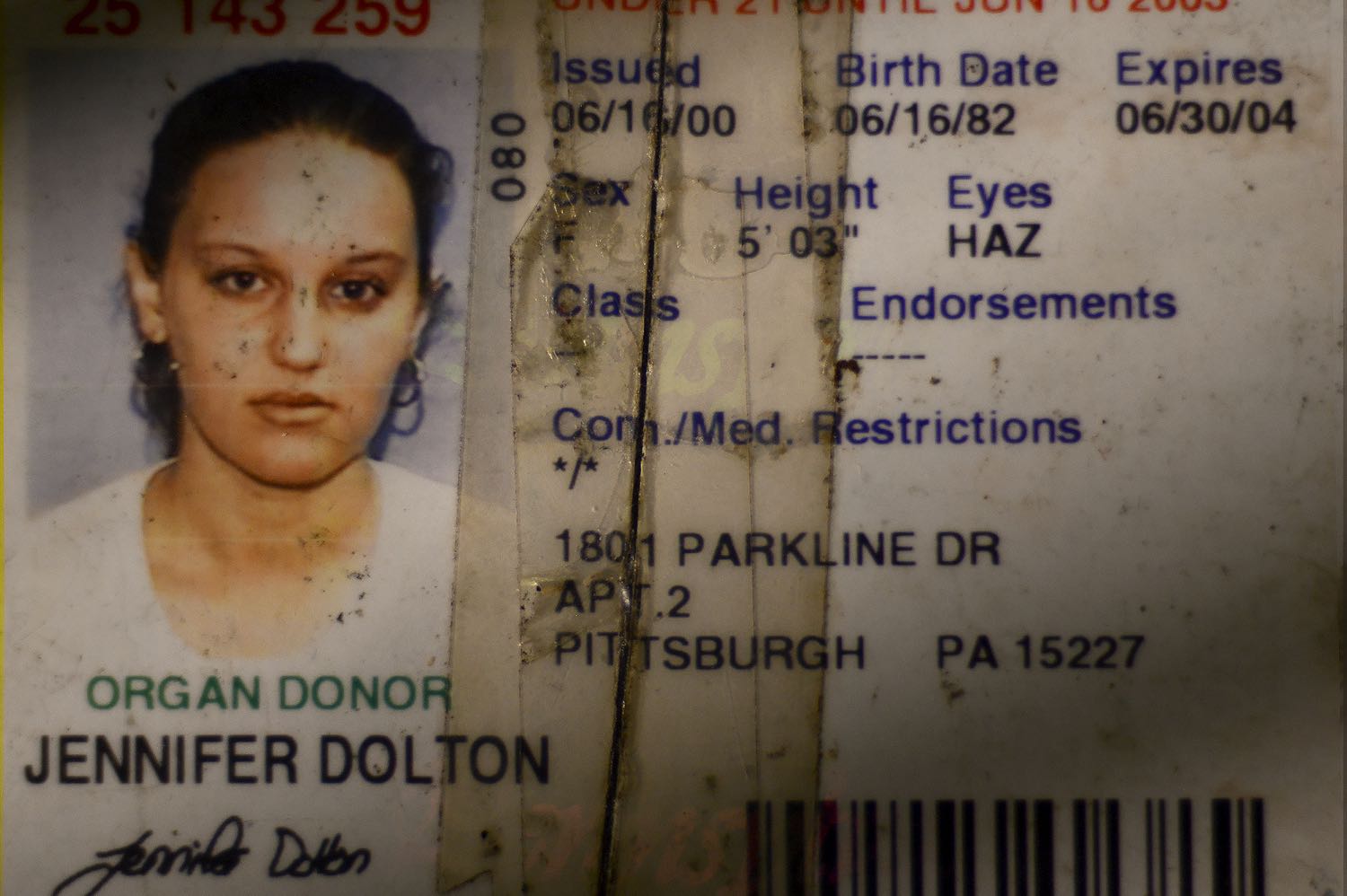
Jenn Dolton’s ID from June 2000.
“I don’t think any of yinz understand … how completely devastated I was when Lisa, Heather, brother (Bill), & a few of other close friends I considered family died,” she wrote. “I wish it would of been me. Not them & I really did try my best to make it me but for some reason GOD decided to keep me in this world to keep causing my loved ones to suffer & this world is hell to me.”
Then she offered good news: She’d not used dope since January, “NOT EVEN ONCE!”
On Aug. 8, her release day, Jenn paused by the cell of a friend, knocked on the window and made the sign of a heart with her hands. “Keep your head up,” Jenn said.
Jenn was free. She was clean. But she had no place to go except the same streets she’d left behind months ago.
“She didn’t have anybody but 16 years of drug friends,” said her mother Diane Dalton. “She was afraid.”
One day after Jenn’s release, Glenn Jeffries gripped a dope-loaded syringe in his hand and leaned forward, looking for a vein in Autumn’s neck. Glenn was sitting in the back seat of an old Buick Century rattling along West Liberty Avenue. Autumn sat in the front passenger seat. At the wheel was Glenn’s buddy, Eddie Stasik. The three had just scored some dope in Beechview. The next few harrowing moments became a story they’d tell several times with a mix of nonchalance and amazement in the coming days.
Eddie inherited the Buick from his brother Matthew, who died of a drug overdose in 2015. The vehicle was less an automobile than a rolling, disorganized toolbox, with wrenches scattered on the floorboards and screwdrivers packed into the console.
The car’s movement made things a bit tricky for Glenn. He couldn’t get the needle in Autumn’s vein. Finally, Autumn told Glenn to quit trying, she’d wait until they got home to do the dope. So Glenn found a vein in his own arm. Whatever was in that syringe was now in Glenn’s bloodstream.
Moments later, Eddie made a turn and Glenn slumped over. Autumn turned to see her partner unconscious, his skin gray, his lips purple. She screamed, “Oh my God, Glenn! Glenn!”
By now, Eddie had turned onto Saw Mill Run Boulevard. A traffic light at the Bausman Street intersection turned red. Eddie brought the vehicle to a stop. He couldn’t think. Autumn was screaming. His friend was dying.
Video Glenn Jeffries: “You just really can’t quit.”
Autumn jumped into the back seat. Eddie kept a container of water in his car so Autumn splashed some on Glenn’s face. He blinked but didn’t seem to be breathing. Autumn started CPR.
The light turned green. Eddie accelerated north on a section of Route 51 hemmed in by ugly, low-slung brick buildings and a concrete barrier. “Pull over, pull over!” Autumn screamed. Eddie kept driving. “Eddie, what are you doing? Pull over!”
Eddie made the turn at Ensign Avenue, then pulled into the parking lot of a methadone clinic. A clinic staff member emerged and hit Glenn with the opioid reversal drug Narcan.
Glenn opened his eyes, saw people looking down at him. Eddie heard someone say authorities were on the way. “Let’s get out of here,” Glenn said. Eddie accelerated onto Route 51. The Buick rattled toward Santron Avenue while Glenn sat in the back seat and puked into a bucket.
The next day, Glenn and Eddie recounted their wild ride and Glenn’s brush with death. Eddie later recalled Glenn asking, “Why did you have to save me?” The question would stick in Eddie’s mind for weeks.
Terry Fisher, a lanky man of 54 who says he’d surely be dead if not for the quick action of his teenage daughter, lives next door to Glenn and Autumn. Terry knew Glenn as an infant in Fayette County, where they were both raised. Terry moved to Pittsburgh a few years ago and liked city life. He could walk to the corner market and buy cigarettes. In Fayette County, he had to drive miles for a pack of smokes.
His daughter Jalynn, 16, moved in with him in 2014. Before heading to school in the morning, she calls out, “Love you, Dad.” Terry responds, “Love you, too.” It’s a routine.
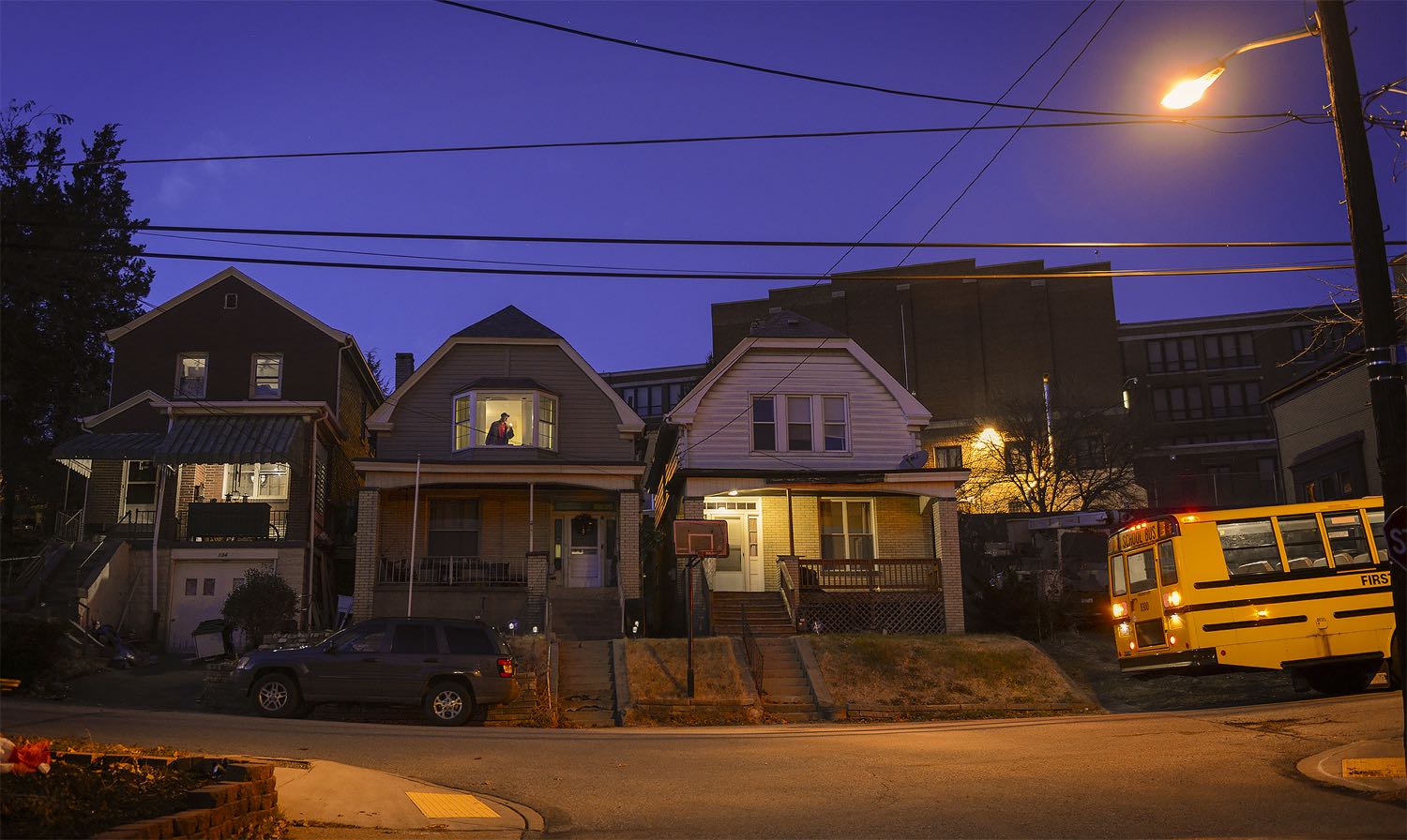
Terry Fisher lights a cigarette in his home on the 100 block of Santron Avenue in Pittsburgh’s Carrick neighborhood. In 2017, opiates exerted a devastating force on this short section of road. (Steve Mellon/Post-Gazette)
Terry once worked in construction. He built homes in Nevillewood. He worked in Cranberry when it was nothing but cornfields. One day his back gave out. Next came surgery and pain pills. Once the pills ran out, Terry said, he turned to heroin.
Jalynn suspected her father was using dope but wasn’t certain until one morning in April 2017. She was in the second-floor bathroom, applying a bit of makeup before heading off to school when she heard a choking sound. She rushed to the TV room and saw her father unconscious on the floor.
Moments earlier, Terry had opened a stamp-sized packet and dumped its powdery contents onto a table next to his chair. He rolled up a small piece of paper, held it in his nostril and snorted the powder. Then he collapsed.
“OK, call 911,” Jalynn said aloud. She had dealt with her share of crises -- family members screaming at each other, fights, drunken relatives. She always stayed calm by talking aloud to herself, a method her father taught her.
After placing the 911 call, Jalynn knelt beside her father. The choking had stopped. “He’s not breathing,” Jalynn said. She lifted her father’s head. Terry resumed choking. Jalynn knew he was getting oxygen. Then the sound stopped. Jalynn set his head back down, lifted it again. The sound returned. “OK, when I do this, he’s breathing,” Jalynn said.
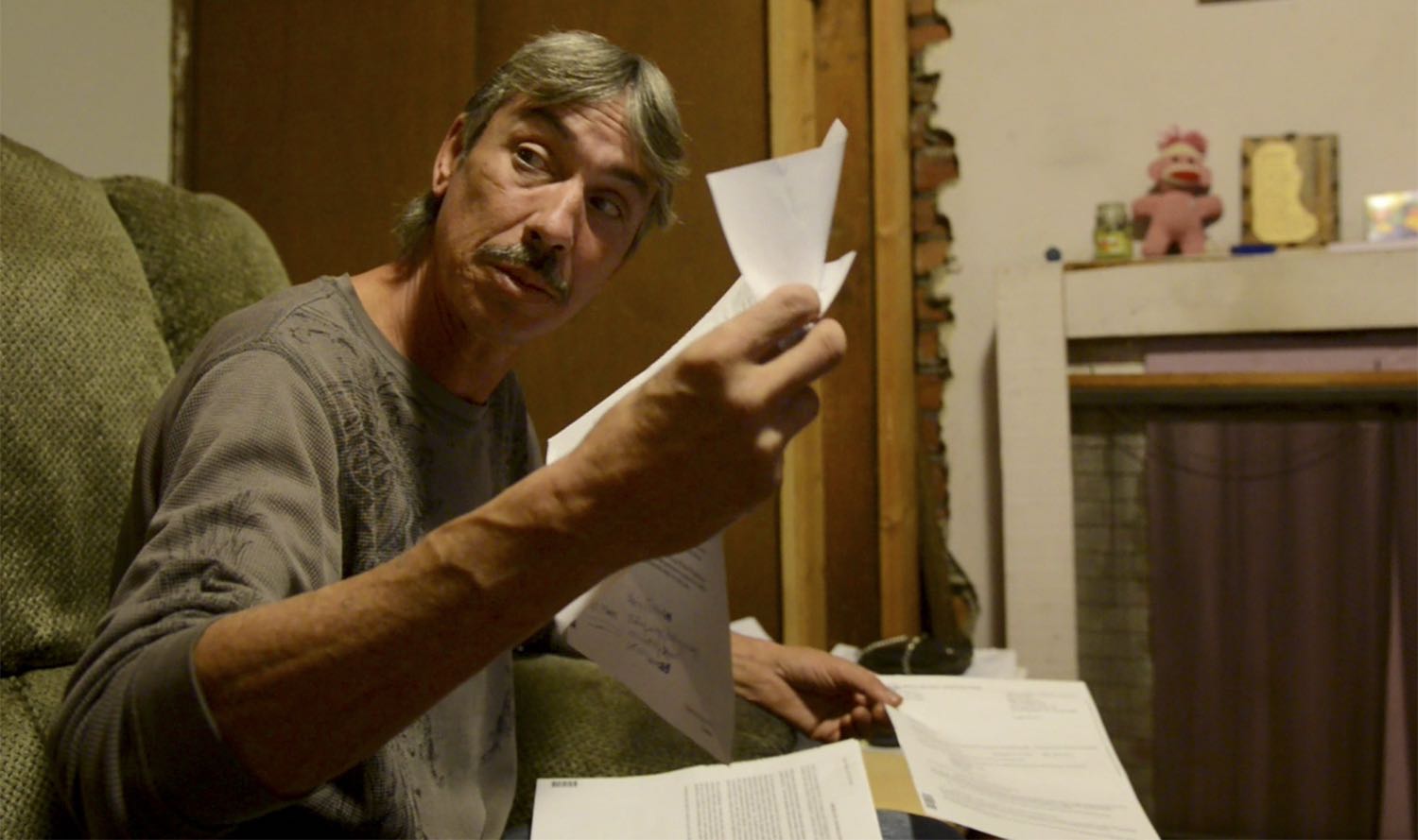
Terry Fisher in the second floor of his home. (Stephanie Strasburg/Post-Gazette)
Terry floated in a sea of white light, he later remembered. He saw no trees, no sky. He was at ease, relaxed. No fear. With him was a woman with blond hair. She wore a white halter top. She, too, was floating and said nothing, but Terry was ready to follow her wherever she was going. He liked this place and wanted to stay.
Then he heard a voice, faint and in the distance. “C’mon Terry, Jalynn’s here, she’s waiting for you,” the voice said. “You need to come back and take care of your daughter.”
Paramedics arrived at the Fisher house and injected several doses of Narcan into Terry. One paramedic called out to him, mentioning Jalynn’s name. Jalynn sat on a small plastic chair a few feet away and watched.
Terry regained consciousness. Paramedics helped him walk out of his house and into a waiting ambulance.
Now Jalynn was alone. She walked a few blocks to Phillips Park. Was my dad OK? she wondered. What drugs did he do? Will I have to take care of myself?
After a while, Jalynn walked to Carrick High, but she was too anxious for class and returned home. Later in the day, Jalynn was sitting on her front porch swing when she she saw her father walking down the street. Relief washed over her.
Terry stepped on the porch and fessed up. He’d been using heroin for about a year.
“Dad, please stop,” Jalynn said.
Terry promised he would, though staying clear of dope’s impact on Santron would prove impossible.

John Sefchick with daughter Jenn as a child. (Family photograph)
As a child, Jenn Dolton had long blond hair often pulled into pigtails. One photograph shows Jenn and her father, John, asleep in an easy chair. Jenn is 4 or 5 years old. She’s in John’s arms, wrapped in a blanket with her eyes closed. She appears angelic.
“Those were the cute years, the good years,” John said.
He and Jenn’s mother, Diane Dalton, were together in the early 1980s and gave birth to two daughters -- Jenn and then Jessica. The couple split in the mid-1980s, and Diane Dalton (her family uses two different spellings of the last name) eventually moved with her daughters to Glassport, a struggling blue-collar town 10 miles from Pittsburgh. The girls visited their father on weekends, and he’d take them to a beach or a park. Jenn attended dance school and liked ponies. John once rented one for her birthday.
By the time she was a teenager, Jenn was living with her mom and siblings above a bar in a three-story apartment building in downtown Glassport. Across the street loomed a boarded-up train station.
It was a tough place to raise a teenager. Diane would call John to say Jenn was drinking or skipping school or sneaking out of the apartment at night.
Then one day, at age 16, Jenn found what she wanted. She was working in the food court at Century III Mall when a young man named Chris Traud, then 18, arrived to meet a blind date. The date never showed up, but Jenn saw Chris, left her job and followed him to his car. When Chris got in, she hopped in, too, and locked the door.
“You have nice shoes, you’re short and stocky, and you’re cute,’” she said to Chris. “‘You have blue eyes and dimples and perfect teeth. You’re perfect.’”
Several weeks later, Jenn discovered she was pregnant.
At first, Chris and Jenn lived with Diane. Then the couple moved into an apartment. Chris worked, making $7 an hour. “Everything was a struggle,” he said. “We scraped by...we was poor but we was happy.”
Diane thought the two were cute together. Chris was always hugging and kissing Jenn, telling her, “I love you.”
Daughter Tanielle was born in 1999. Jenn was a good mother in those days, according to Chris, and she managed the family finances. Son Daylin came along in 2001. Five months later, Jenn and Chris made it official: They said their vows at Richard King’s magistrate office on Brownsville Road.
Chris grew up without a father until a man named Al Leonard entered his life. Al served as Chris’ counselor, but his involvement in the young man’s life soon went much further. “I always felt like nobody cared about me,” Chris said. Al “was the only person who took the initiative to insert himself in my life, make it structurally sound.”
Once Chris and Jenn married, Al helped the couple pay bills. He took them to the zoo, to Kennywood Park. Then he told Chris to pick out a house. Chris and Jenn fell in love with a four-bedroom yellow brick house on West Woodford Avenue. Chris could imagine raising his family there.
In 2002, Al paid the $38,000 sale price, and he and Chris signed the deed.
Jenn selected new carpet, flooring and paint colors. Chris remodeled the bathroom. And for years, the couple hosted family gatherings at their West Woodford home. On Thanksgiving, Christmas and Easter, Jenn’s family -- Diane, Jenn’s sister Jessie and others -- came together as Jenn cooked turkey and ham and filled a table with side dishes.
Everyone played games and sang karaoke tunes, Jenn dancing and daughter Tanielle joining in. For the most part, everything seemed normal.
Chris remembers a snowy winter day when he and Jenn walked through the neighborhood, its lawns covered by a blanket of fresh snow.
“I got to walk through this yard,” Jenn said.
“Why?” Chris asked.
“Because it looks too perfect. It’s like my life.”
So Jenn tromped through the perfect yard, marking it with her footprints. Afterward she cried. At the time, Chris couldn’t make sense of it.
Glenn Jeffries grew up in the Fayette County village of Lowber, which he calls a “little coal mining town.” He was one of nine boys who hung out together, riding bikes and playing sports.
He attended Frazier High School but didn’t stay long. “I quit school and got a job in a junkyard,” he said. “And then I ended up coming to Duquesne and McKeesport to cut those mills down. Demolition work. Then I went to jail.”
Glenn’s trouble with the law began in earnest sometime after midnight on May 10, 1997, when his father, James Jeffries, led state police troopers along a creek in Lowber. James stopped near some damp soil. “He’s right here,” he told the troopers, according to their report. “I can smell him.”
Police shoveled away a bit of dirt, then hit something soft, the report says. It was a human torso with the initials “JK” tattooed on the skin.
James showed troopers a .22 caliber rifle and a bloody ax, both hidden in bushes. The torso belonged to a man named John Patrick Keane. Keane often hunted and drank beer with Glenn and his brother Jimmy.
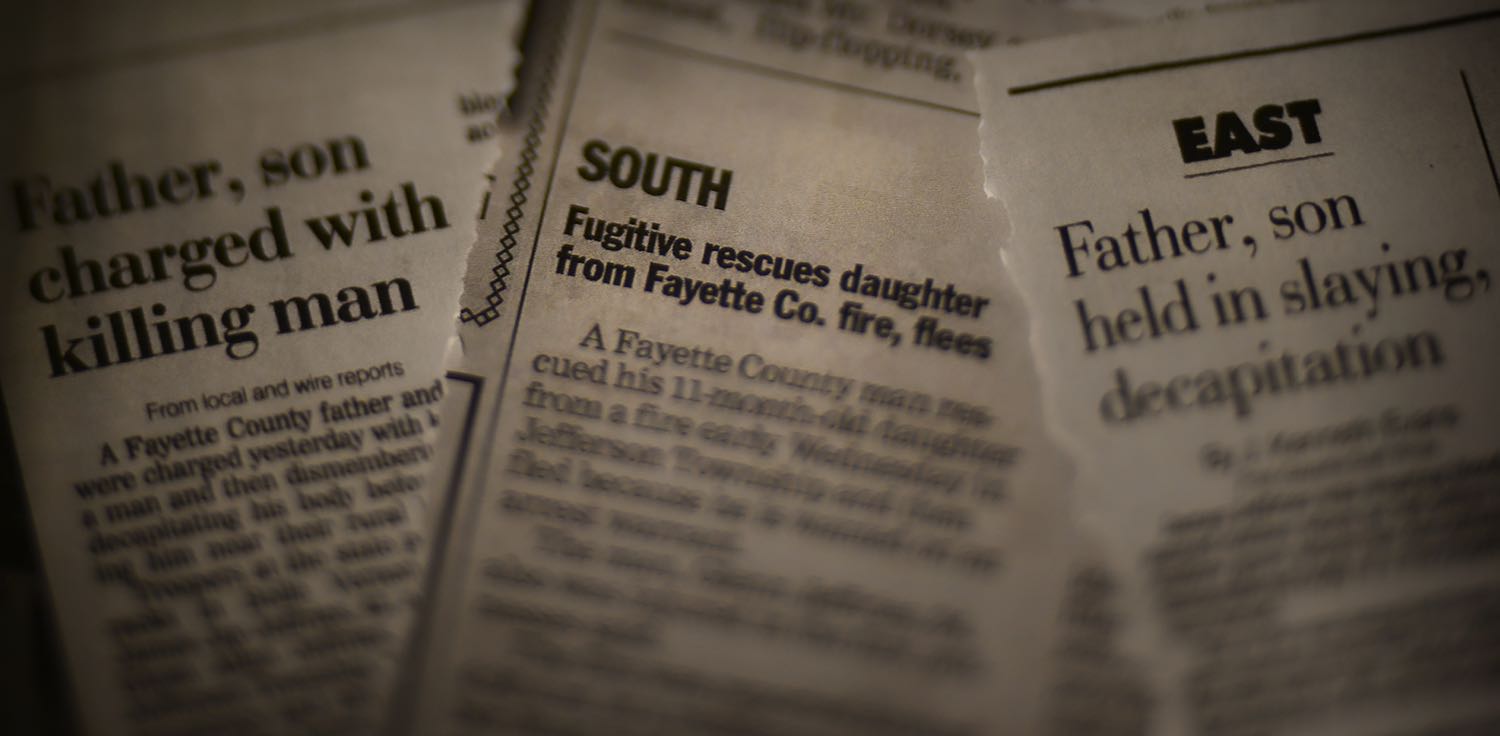
Glenn Jeffries came from a troubled past in Fayette County.
Both father and son were soon charged with third-degree murder and abuse of a corpse. Glenn pleaded no contest and agreed to testify against his father. In return, Glenn was sentenced to five to 10 years in prison. James was convicted and sentenced to 20 to 40 years.
Glenn was released after five years, only to land back in prison for a parole violation in October 2004.
Five years later, he was again free. His name soon turned up in Fayette County police reports that accused him of stealing various items -- a log splitter, an air compressor, vinyl windows.
In November 2009, police serving a warrant at Glenn’s Fayette County home encountered Autumn Dawn Rudolph.
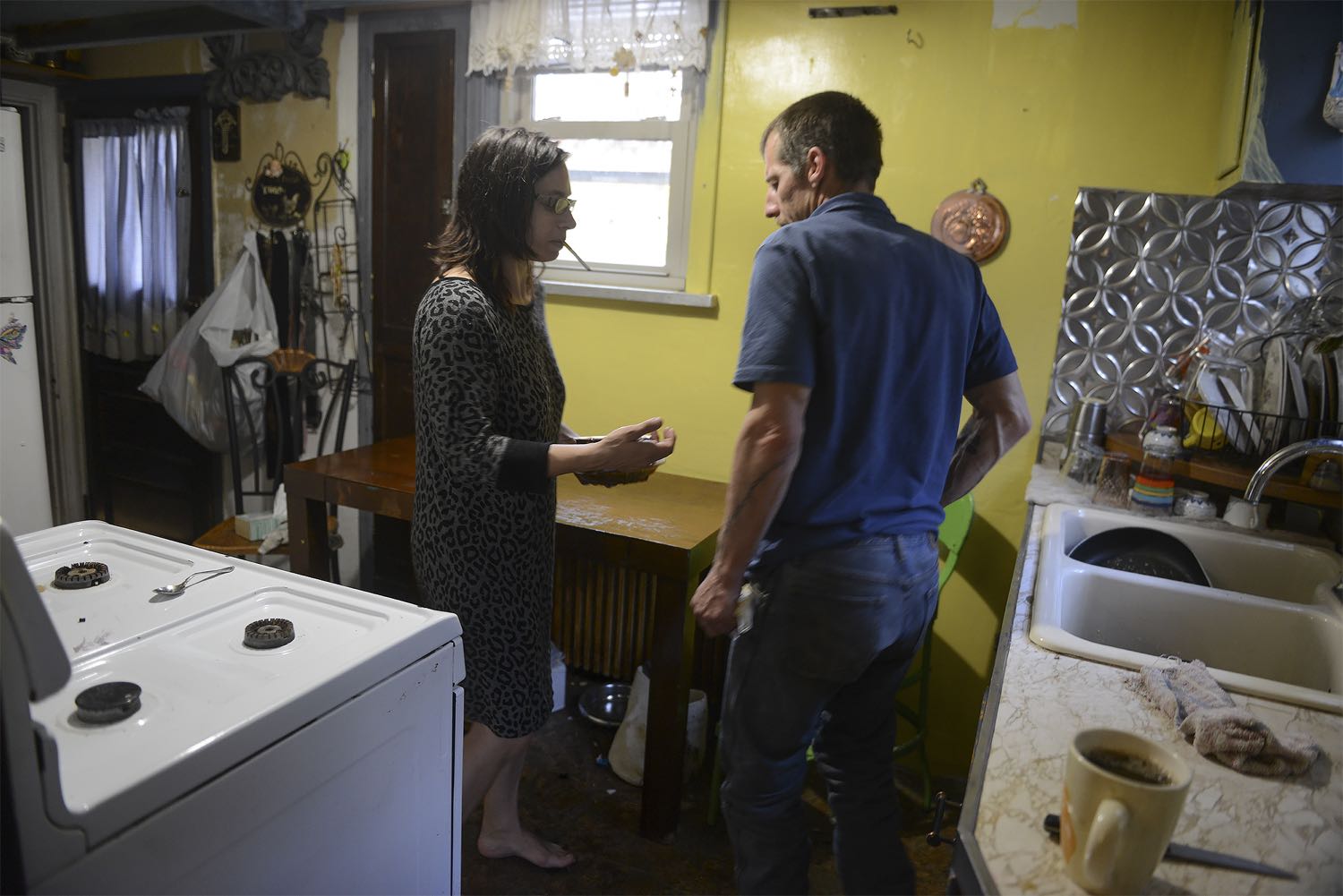
Autumn Rudolph asks partner Glenn Jeffries for a light in the couple’s kitchen. (Steve Mellon/Post-Gazette)
Autumn, 37, said she spent much of her childhood near Sheffield, Pa., in Warren County. At one point, she moved with her mother to Rochester, N.Y., and hated it, so Autumn ran away from home at age 13 and lived with a boyfriend. A few years later, the boyfriend was sent to prison and Autumn fell into another relationship that resulted in two daughters. “But I ended up drinking a lot because me and him didn’t get along too much,” Autumn said. “I ended up getting into a lot of trouble. My mom ended up with the girls.”
Autumn lost her job at a state hospital. She moved to Pittsburgh to attend business school and met Glenn in an online forum. The couple’s first date was typically Pittsburgh -- they went to Kennywood Park. She liked Glenn because “he wanted to have fun. He wasn’t real uptight.” The two clicked.
By 2010, the couple had an 11-month-old daughter named Cathy and plenty of trouble. Autumn and Cathy lived in Lowber, in a one-story building with an attic loft that served as a bedroom; Glenn stayed in Pittsburgh because Fayette County cops were looking for him. One day in late April of that year, Glenn hitched a ride to Lowber to visit his wife and daughter.
Around 4:30 the next morning, Glenn and Autumn were awakened by strange “clicking” noises and the smell of smoke. Glenn climbed out of bed, and when his feet hit the floor, he said, “it was like a hot plate.” Fire was consuming the room below.
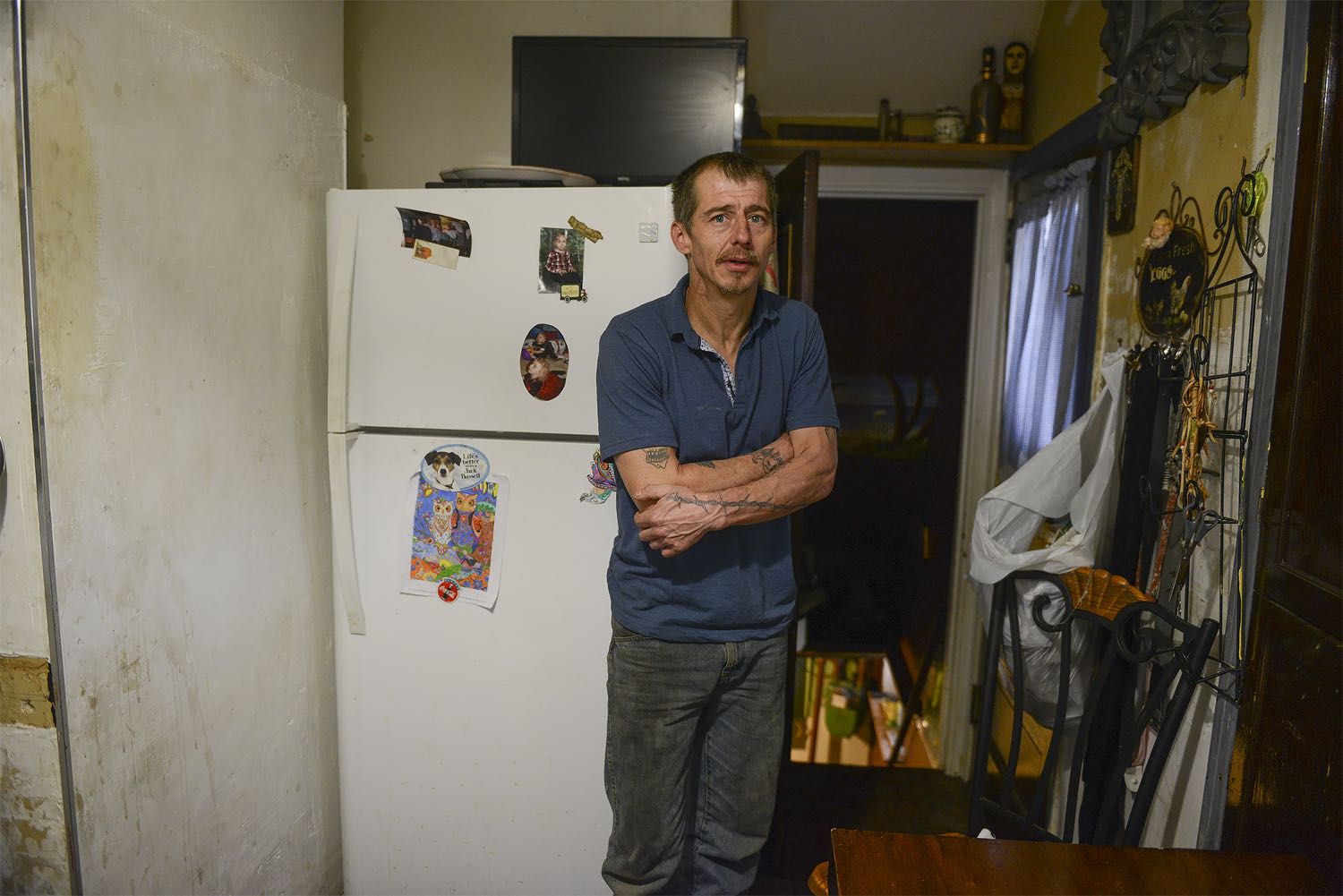
Glenn Jeffries at home on Santron Avenue. (Steve Mellon/Post-Gazette)
Glenn ran to the room where Cathy slept. Flames were melting the curtains. Glenn grabbed Cathy’s crib by its legs and pulled it out of the room, burning the flesh on his fingers.
He reached down and lifted Cathy -- she was so hot “it was like lifting ham out of the oven,” he said.
Glenn ran out of the house and put Cathy on the ground. Autumn had fled to the roof. Flames poured from windows. Glenn climbed up and helped Autumn to safety.
Sirens neared. Glenn fled. He feared arrest.
Burns covered 80 percent of Cathy’s body, relatives said in news reports. She was treated at UPMC Mercy, then flown to Shriners Hospital for Children in Cincinnati.
One relative told reporters Glenn was “a hero. He went in there and got her. If it wasn't for him, she wouldn't be here, she wouldn't be alive."
A week after the fire, police arrested Glenn as he attempted to visit his daughter at the Shriners hospital.
In October 2002, Chris Traud received a card from Al Leonard. Inside was a diamond ring Chris had once given Al, Chris’ insurance cards and $1,000. A note instructed Chris to check on Al’s house in Homestead.
Chris contacted Homestead police, but they already knew. Al had killed himself.
The loss of the one man he could depend on devastated Chris, but Jenn helped him deal with the grief. “She kept me strong when I was weak,” he said.
The couple soon discovered Al had left them more than $100,000. It was his final gift to them, and for a while it seemed like a blessing.
“We took vacations, spoiled the kids,” Chris said. “We had everything we needed. A car and a house. Things were too easy … so I spent it. One hundred grand in two years.”
Chris and Jenn also bought cocaine. Lots of it. The couple had used the drug on weekends, according to Jenn’s mother Diane. But now Jenn and Chris began using daily. Jenn also developed a pill addiction. She told family members the addiction began after she injured herself on a playground slide. Jenn visited one doctor after another in her efforts to obtain prescriptions, friends said.
Still, a sense of normalcy remained at the West Woodford house. Sondra Goller, a teenager living down the street, often visited Jenn. Sondra said Jenn would typically be cooking while Chris and the kids played video games. The family went swimming or to a park during warm months.
Sometime around 2011 or 2012, heroin entered the house.
At first, the couple snorted dope. Then a friend saw them using and said, “You’re wasting it.” He showed the couple how to use a needle. “You never go back to sniffing after you shoot,” Chris said.
Family life quickly crumbled. Strangers showed up at the house and stayed. The kids were hungry, the rooms a mess. Sometimes Tanielle and Daylin came home from school and discovered they’d been locked out of their house. They’d walk down to the Goller home, where Sondra’s mom would feed them.
Jenn spent most of her time sleeping. She’d wake up for dinner, then fall asleep at the table, her head sometimes plopping into her food while her kids watched. “You’re going to kill yourself, mom,” Tanielle said. Her words had no effect.
Soon the addiction was costing the couple as much as $280 each day. Chris lost his job of 14 years, so he cut grass to make money. It wasn’t enough. Bills went unpaid. Jenn’s father, John, loaned her money for groceries, but the money bought drugs.
Tanielle said her dad taught her to steal food at the UniMart so she and her brother could eat. “He called it his ‘slip-and-slide,’ and he would just slide it up his sleeve,” she said.
When she was about 12, Tanielle watched a man overdose in her family’s kitchen. Her parents “just started freaking out and told me to get upstairs.”
Tanielle remained on the stairs while her father performed CPR on the man until an ambulance arrived. “I felt really nervous, I didn’t know what to do,” Tanielle said.
One by one, utilities at the house were shut off. The kids walked to a neighbor’s house to shower and at night piled blankets on their beds to stay warm. On cold winter mornings they’d wake up to see frost covering the inside of the windows.
Eventually it became too much for Tannielle. After school on a snowy afternoon in January 2015, she walked to Brownsville Road, stood on the steps of a stone church and called police. Then she went home.
“Why would you do this to me?’” Jenn screamed at Tanielle once she learned police were coming. Jenn quickly gathered her drug paraphernalia and ran through the snow to the garage, where she hid the evidence.
Police had no problem finding it. “Her footprints were in the snow,” Tanielle said.
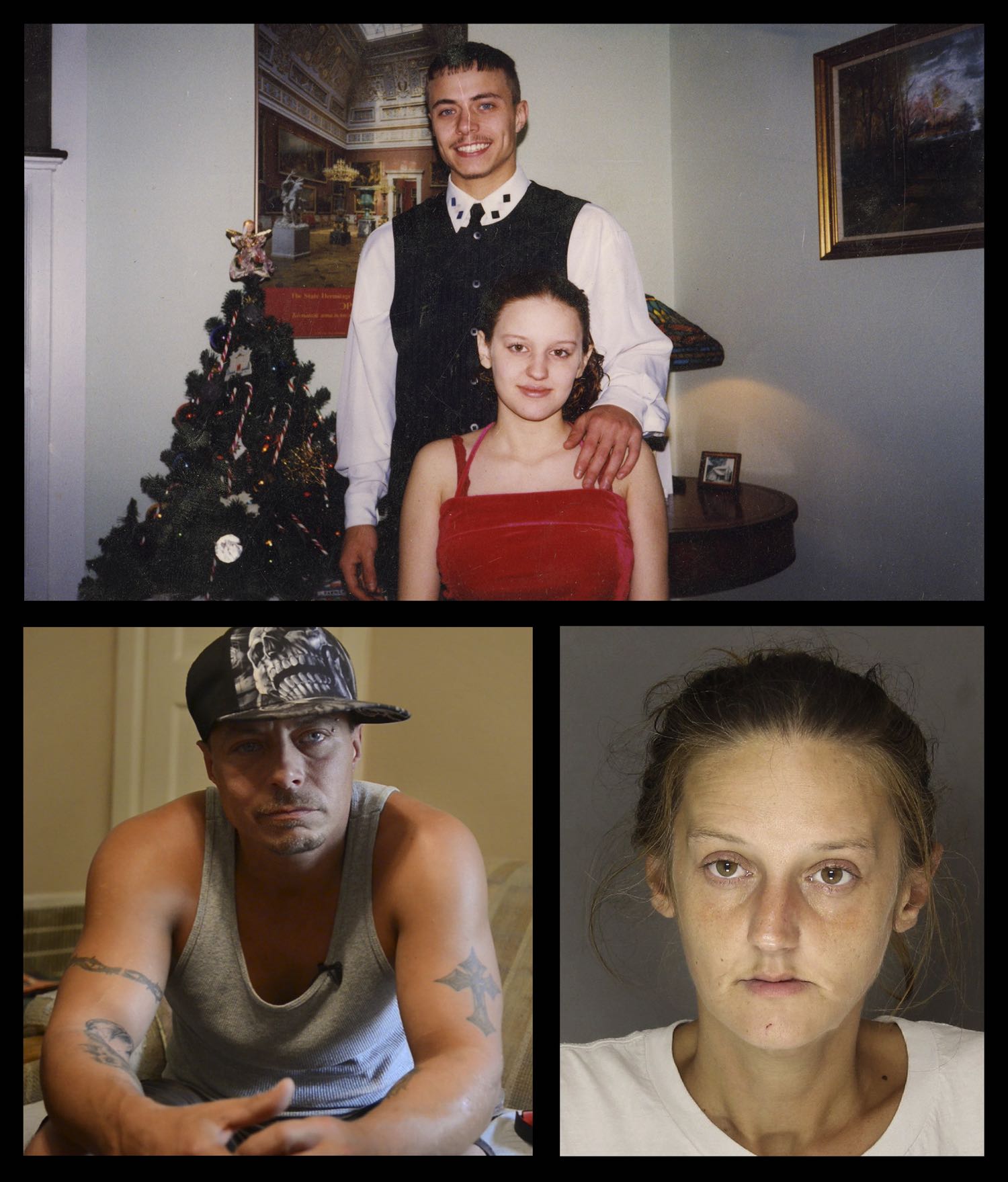
Chris Traud and Jennifer Dolton (top) celebrate Christmas shortly after they met in the late 1990s. Chris in 2017 (bottom left) and Jenn in an Allegheny County Jail booking photograph taken in 2016. (Family photo, top; Stephanie Strasburg/Post-Gazette; Allegheny County Jail photo.)
The kids went to live with Jenn’s sister Jessica in Greensburg. Jenn and Chris were now alone with their addictions. They stripped copper piping from the basement and sold it for scrap. To stay warm, they stole wood from a neighbor’s pile and burned it in the basement. Someone loaned Chris and Jenn a generator, which they placed on their front porch. It ran day and night, supplying electricity. Neighbors complained about the noise, so Chris brought the generator inside, to a second-floor bedroom. The generator was removed after it caused a small fire.
Chris was in and out of jail. After one stint behind bars, he returned home only to be told by Jenn, “You’ve got to leave.” Chris refused and the two argued. Soon a car stopped in front of the house. A man was at the wheel. Jenn ran outside and hopped in.
“I put two and two together,” Chris said. Jenn was working as a prostitute.
He called Jenn and told her to come home in 20 minutes. He’d just bought dope, so he went into the bathroom and sat on the toilet seat, his usual spot when using. “I shot up and made sure it was enough to kill me,” he said. Jenn found him and called 911. First responders revived Chris with Narcan.
From then on, said Chris, “She did her thing and I did mine.”
Chris’ path led again to jail, where he finally made a decision to get clean. “I cried to myself for a week, like a baby,” he said. “I just let go and let God (take over)."
By 2014, Glenn Jeffries was out of prison. He’d moved to Pittsburgh to join his wife and now two daughters -- Carly was born while Glenn was serving time. The reunited family lived in a Santron Avenue house owned by Russell Schmitt. Russell’s Christmas tradition of sending money orders to random inmates had brought him and Glenn together.
One day a friend asked Glenn if he could shoot dope in a shed in Glenn’s backyard. Glenn said OK. It was a disastrous move. Dope soon entered the house and both Glenn and Autumn were using. Glenn said the addiction took hold after only a few days. If he and Autumn didn’t use, they got sick. “I thought you could just quit,” Glenn said. “But you can’t just quit.”
By 2017, Glenn and Autumn had developed a tolerance for heroin and were using dope containing fentanyl, a potent synthetic drug that can be lethal even in small doses. The addiction was costing the couple as much as $200 each day.
For a while Glenn earned money by cutting down trees. He had a beat-up old lift truck for that purpose. Sometimes in the summer, he’d chug down Brownsville Road in the vehicle, which then had two mattresses strapped to the roof. Glenn could make up to $700 a day cutting trees, but the money never lasted. Addiction ate it up.
One late summer day Autumn sat on a brown couch in her living room and felt normal. She and Glenn had just injected five bags of dope. “Now I can take my kids bike riding without being sick,” she said.
Video Autumn Rudolph: “My stomach is full of butterflies.”
Glenn plopped down in a nearby easy chair. The house on this day was neat and well-ordered, except for a small pile of clothes in the dining room. Crosses hung on the walls and a large Bible occupied a display shelf, but Autumn said she and Glenn weren’t religious. Pictures of the couple’s daughters filled a frame hanging near wall markings that followed the girls’ heights over the years.
The children now lived across the street with Russell. CYS had placed them there in May, while both parents were in jail. Autumn said her daughters’ removal sent her into a depression and for weeks after her release from jail, she rarely left her couch. On this day she talked about getting clean, getting the kids back and moving to Sheffield so the family could start a new life.
She and Glenn were hoping to get into treatment programs. “He’s gotta go first,” she said, motioning to Glenn. “You can’t be clean when you’re living with a user. We both gotta be in the same boat.”
Listen as those who loved Jenn Dolton share their last encounters with her, the happy times, and her addiction's grim course. We found memories from the windy streets where users wait for dealers to the abandoned house littered with her clothes and stained spoons.
Jenn Dolton’s body was discovered on the back porch of a vacant home on Santron Avenue. (Stephanie Strasburg/Post-Gazette)
In the days after she was released from jail, Jenn Dolton returned to her old neighborhood, her old friends. She was clean, her tolerance for dope gone. Her intentions, by all accounts, were positive, but her will fragile.
On Aug. 11, a resident of West Woodford saw Jenn standing outside her dark and empty house and lamenting its condition. Jenn went inside, gathered up a bunch of trash and drug paraphernalia and put it in a garbage bag, which broke after she placed it on the curb, spilling stained spoons and other junk.
Later Jenn made her way to Santron Avenue and asked Terry Fisher if she could stay at his place for the night. Terry was struggling to stay clean. He knew Jenn and her history of addiction, but he felt he could trust her if she wasn’t using. He let Jenn sleep in his bed while he snoozed on the couch in his TV room.
Terry kept an eye out for signs of drug use -- extra-long stays in the bathroom, stamp bags left lying around. He saw none. The next morning, Jenn left.
She returned later with a nasty cut on her right wrist. “What happened?” Terry asked. Jenn said someone on Brownsville Road had attacked her with a utility knife. Terry told her she should get it stitched up. Jenn then left.
An ambulance picked her up at the UniMart on Brownsville Road at 1:30 the next morning, Aug. 13. Her wound treated, Jenn called her father from UPMC Mercy. John picked her up around 5 a.m. and took her to a McDonald’s restaurant for breakfast. To John, Jenn seemed in good spirits. He drove his daughter to West Woodford and dropped her off.
Two days later, on Tuesday, Jenn called her mother. Diane was at Idlewild amusement park with Daylin and two of his cousins and couldn’t talk.
“Can I call you back later?” Diane asked.
No, Jenn replied, she didn’t have a phone and was calling from one she’d borrowed.
“Call me back tonight,” Diane said. She told Jenn she loved her.
Jenn borrowed another phone around 1 p.m. on Thursday, Aug. 17. She called her father to say that someone was interested in buying her house on West Woodford. She wanted John to meet the prospective buyer later that day, but John couldn’t, he’d made other plans. After 20 minutes, the two said goodbye. "She sounded fine,” John recalled. “Cheery. She wasn't moody. Wasn't down and out."
Two hours later, a firetruck hissed to a stop in front of Terry Fisher’s house on Santron Avenue. He looked out a window to see firefighters walking toward a path between his house and the empty house next door. He walked downstairs and stepped out his back door to see firefighters standing over a body lying on the wood planks of the porch next door, a dozen feet away. Terry saw a pair of dark shorts, legs that had turned blue. He saw the shoulder-length brown hair.
Uniformed police showed up, then detectives in plain clothes. A bit shaken, Terry sat on a front-porch swing, rolled cigarettes and drank a Genesee beer. Jalynn slept upstairs.
Two detectives crossed Terry’s front yard and walked up the steps leading to Glenn and Autumn’s house. “They home next door?” one of the detectives asked Terry. Terry said he didn’t know. The detectives knocked on the door at 134 Santron, but no one answered.
After a while, one of the detectives approached Terry and held up a cell phone to show him a picture of the person now dead on the back porch next door. “That’s Jenn,” Terry confirmed.
Video John Sefchick: "I don't know what I could have done."
Around 6 p.m., Diane Dalton answered a phone call from a relative who’d received a visit from police. It was something about Jenn. Diane thought maybe her daughter had been in a car crash. Or maybe she’d robbed someone. The relative told Diane to call a phone number. When Diane did, she knew the worst had happened when a voice on the other end answered with the words “medical examiner.”
John Sefchick learned of his daughter’s death 24 hours later, while he and his wife, Pat, were driving two grandchildren to the couple’s camp north of Pittsburgh. The cell phone rang. It was Jessica with the news. John turned his vehicle around at the Camp Horne exit on Interstate 279 North and headed back to Whitehall. He stayed at home while Pat took the grandkids to the camp.
For a while, John was on the phone, arranging his daughter’s funeral. Then he spent the remainder of the evening and the early morning hours of the next day alone with his thoughts and memories.
Saturday morning he drove to Santron Avenue. He wanted to see where his Jenny had died. He couldn’t figure it out. Just a few days earlier, his daughter seemed to be getting her life together. He visited the barren porch. Someone had placed flowers on the bench near where Jenn’s body was discovered.
John knocked on Terry’s door. The two men talked briefly on Terry’s front porch, John said. Terry told John that Jenn had often spoken of him. Terry later recalled noticing John had been crying.
Another neighbor told John first responders had visited Glenn and Autumn’s house several times to treat overdose victims. John considered knocking on the couple’s door but decided against it.
Weeks passed. John couldn’t sleep. Too many questions rattled around in his mind. Too many memories. Like when Jenny was a kid and she would squeeze up next to him on the couch, pressing so close he couldn’t move his arm. In those days, Jenny rarely left her father’s side. John yearned to know how his daughter died. Who was with her? Where did she get the dope?
Many nights John wept. What should I do next? he’d ask. Who should I call? His wallet was littered with small scraps of paper on which he’d written the names and phone numbers of people he thought could help. Detectives, magistrates, anyone who may have answers. He left messages that were never returned. He attended block watch meetings in Carrick. Police in attendance encouraged John, but he learned nothing new. It seemed to John no one was interested in investigating his daughter’s death.
Video John Sefchick: "It hurts."
A few times, at 2 or 3 a.m., the restlessness and frustration overwhelmed John and he would climb into his white pickup truck and drive, out of the borough of Whitehall, down Saw Mill Run Boulevard and up into Carrick. There, he cruised along dark, quiet streets, hoping he’d see something, learn something. Usually, he said, he ended up on Santron Avenue, passing the two-story house with empty lifeless windows. A weathered funeral wreath, held upright by a rusting wire frame, wasted away in the front yard. John had placed it there the week after Jenn died.
One night John pulled into a narrow parking lot beside Carrick High School, which loomed above the homes on Santron Avenue. A security camera attached to the school pointed toward the street. Perhaps, John thought, the camera captured images that could answer his questions. He later told police about the camera and often wondered if they’d ever checked the footage. John brought his truck to a stop. From the parking lot he could look down on the back porch of that empty two-story house, dimly illuminated by the glow of lights in the parking lot.
What happened to Jenny? John wondered. How did she end up down there?
Those questions remained unanswered on Dec. 1, when the Pittsburgh Bureau of Police declined the Post-Gazette's interview requests and instead sent this statement: "We know this is a difficult and complicated time for the family of Ms. Dolton. Sadly, all of the investigative leads have been exhausted. However, this case remains open and is actively being investigated. We are hopeful that additional information will be revealed to help us bring some measure of closure to the family. The Pittsburgh Bureau of Police Narcotics and Vice Unit thoroughly investigates every overdose death in the city."
Diane Dalton returned to Glassport on a warm Sunday evening, Oct. 22, and joined a gathering of about 100 people at a small memorial park in the center of town. A photographer had set up a small outdoor studio at the edge of the park. A woman stepped in front of the camera and held up a small sign. “Addiction took my brother and sisters,” it read. The camera clicked. A small boy held a sign reading, “Addiction took my mommy and daddy.” Next were two women who’d lost their brother and sisters. On and on it went.
As darkness approached, a few speakers addressed the crowd. Then Diane stepped to the podium.
“Nine weeks ago I lost my daughter,” she said. “I don’t know how I’m going to get through next month. I’m lost, I’m hurt. I’ve started three grief groups. I talked to a lady last week. She’s still in it 12 years later … I don’t know what else to say. I’m sorry. Thank you.’’
Video Diane Dalton: "Unfortunately I didn't get my kids out in time."
Do you appreciate good journalism? If you do, consider subscribing.
Support journalism. Subscribe today.

If you are a loyal subscriber, thank you for your support.
Heroin mixed with fentanyl. (Steve Mellon/Post-Gazette)
Three weeks later, Glenn Jeffries sat on the steps leading to his front door and described two mundane and harrowing summer days of addiction. In the process, he may have provided some answers to the questions haunting Jenn’s family.
Glenn said Jenn visited his house on Wednesday, Aug. 16, one day before her death. Glenn, Autumn and Jenn had bought dope costing $10 a bag, he said. The dealer warned Glenn to be careful, the dope was strong stuff. Jenn used half a bag and fell unconscious. Glenn said he revived her. “She knew she couldn’t handle it,” he said.
The next day, “we were getting sick,” Glenn said, so he bought a few bags and the three again gathered at Glenn’s house. Glenn mixed dope in spoons for both he and Autumn. Autumn asked Glenn to shoot her up. When he did, “Jenn went over and stole my stuff,” he said. “She sucked it up out of my spoon [with a syringe] and shot it in her arm. I saw that it was missing and I flipped out and told her to get out of here.”
Jenn made her way to the porch next to Terry’s house, he said. Later, Autumn stepped out into her backyard and saw Jenn, who seemed unconscious. Autumn called 911 “and we just left,” Glenn said. The two went to a friend’s house nearby. Moments later, first responders rolled to a stop on Santron Avenue.
Shortly after 8 a.m. on Thursday, Nov. 16, Glenn prepared what he calls breakfast. He leaned over the kitchen sink and held a syringe with a bent, clogged needle in a stream of water spewing from a spigot. Glenn had no new needles. This one had to work.
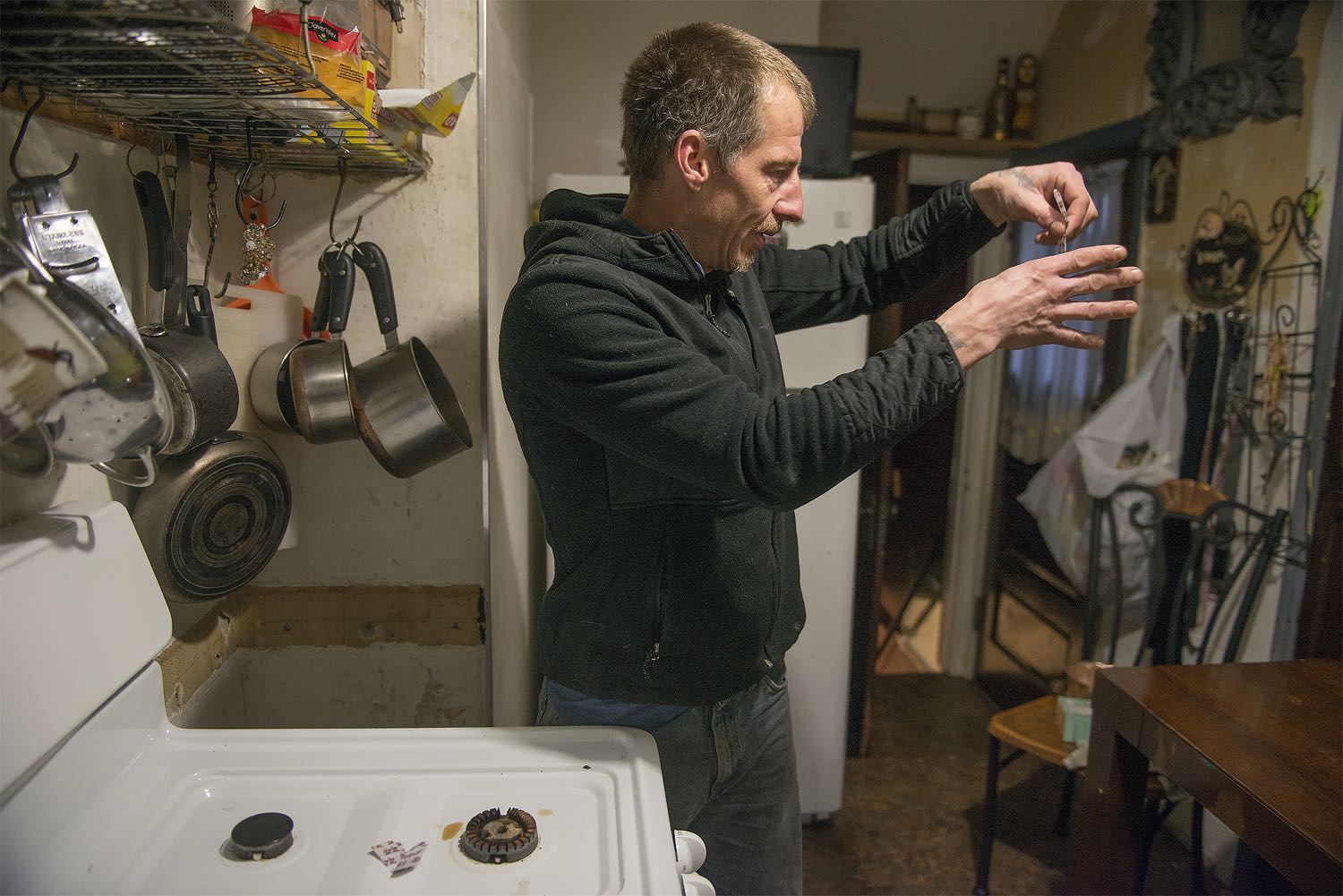
Glenn Jeffries was scheduled to leave for rehab on the morning of Nov. 16. Before, he made one last dope buy. This morning’s dope was labeled “Wildcat.”
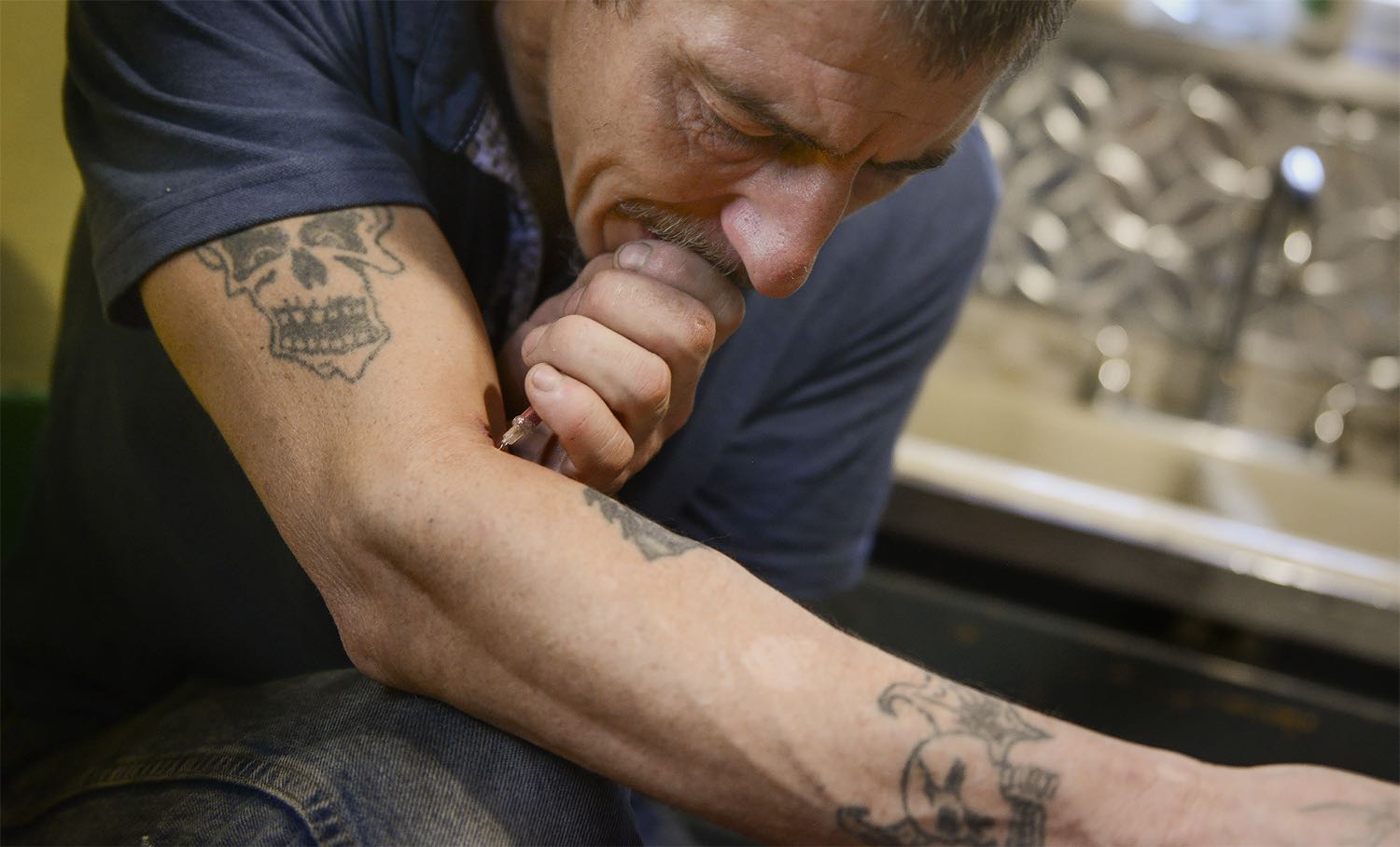
After mixing the dope with water in a spoon, he sucked it up into a syringe and plunged the needle into his arm.
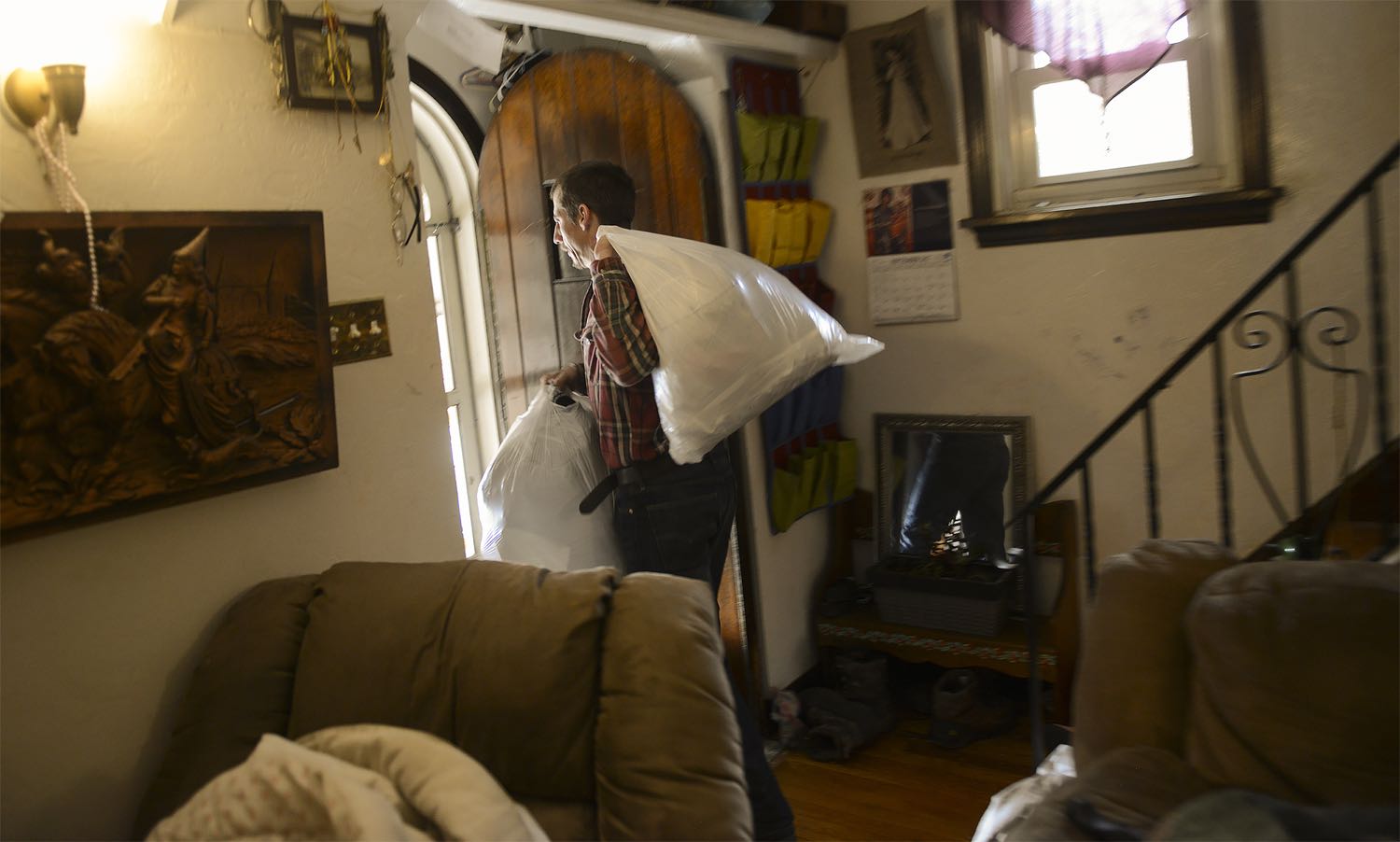
Autumn had packed his clothes into two white garbage bags that served as luggage.
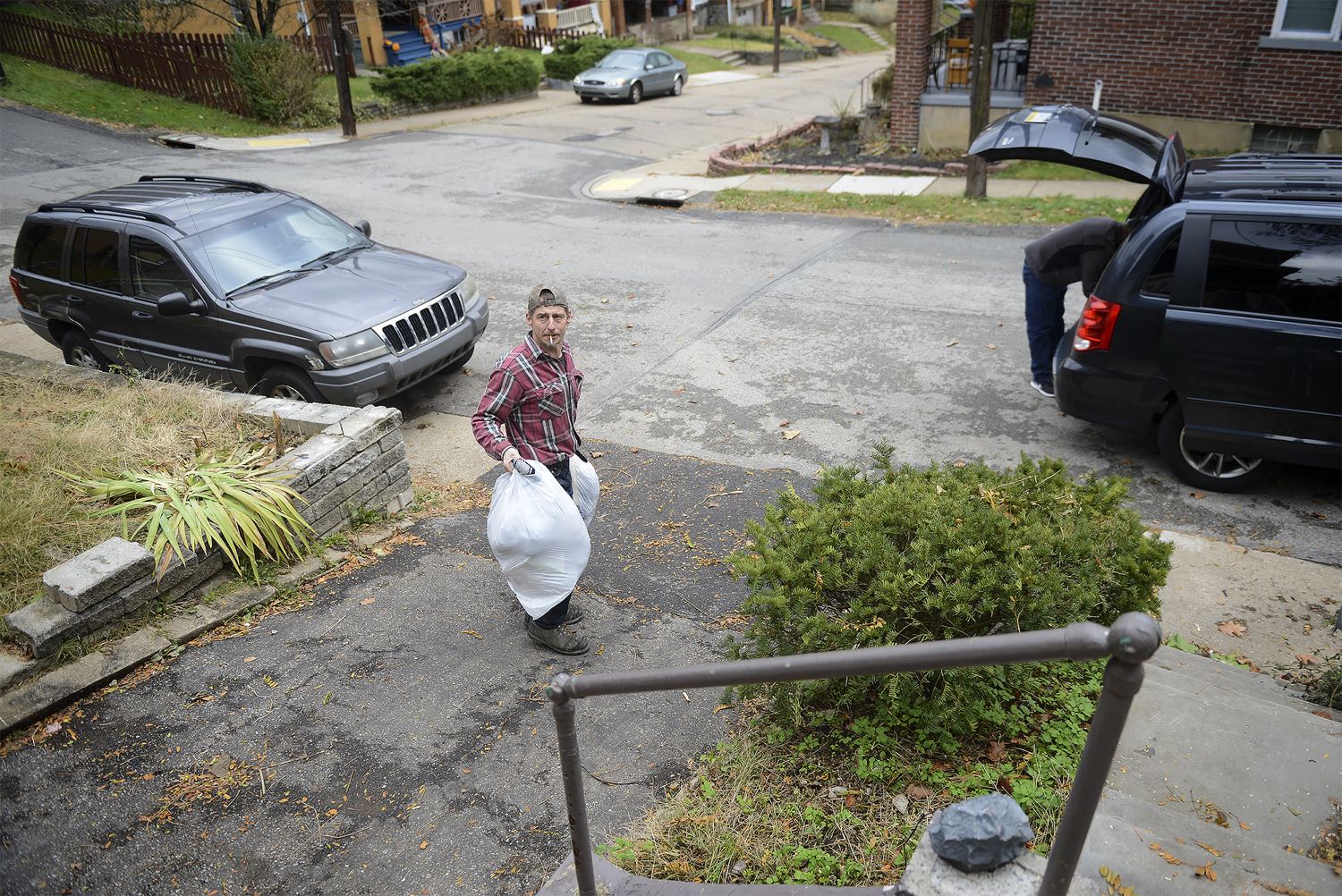
Glenn put on clean jeans and a plaid shirt.
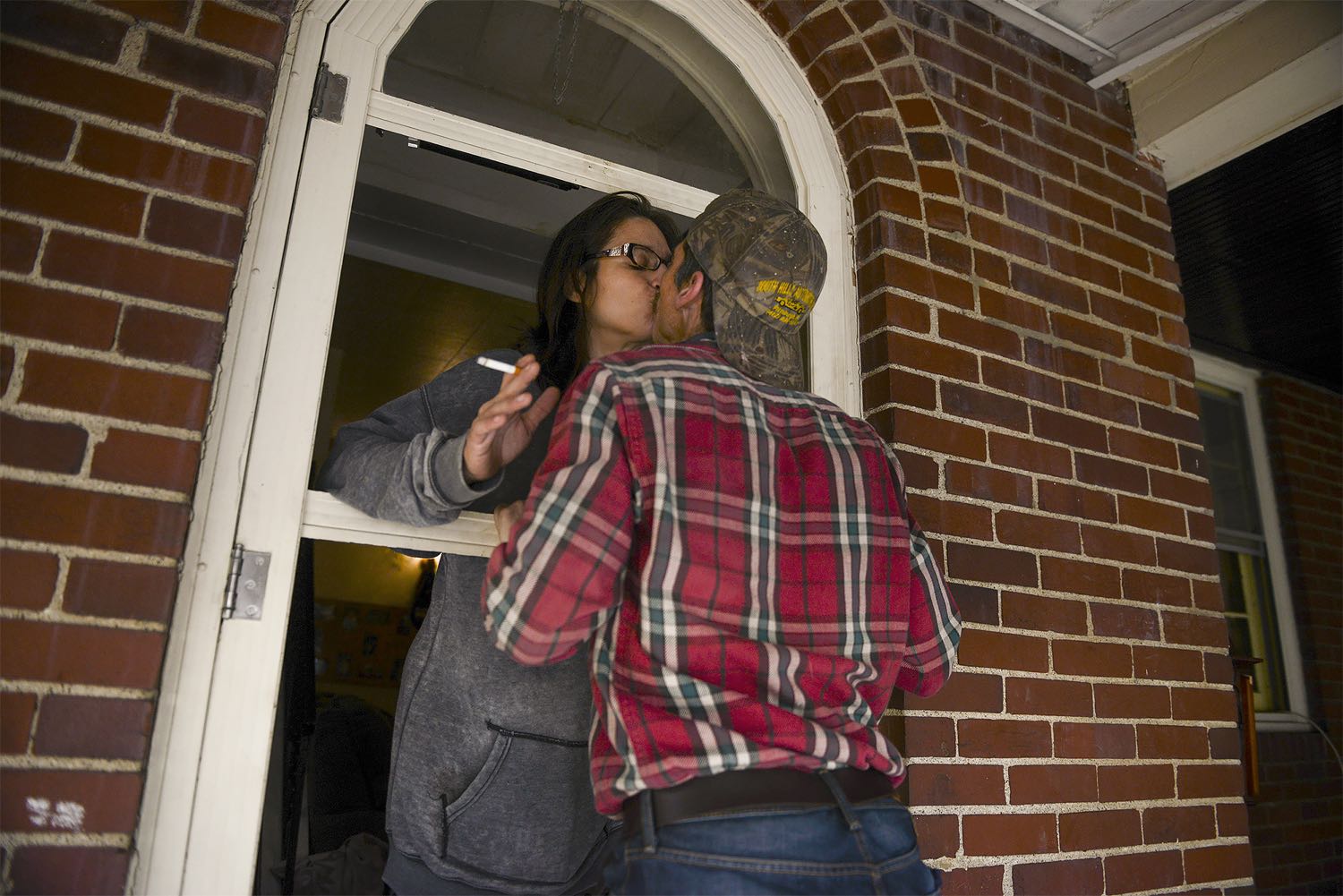
Autumn wished him luck as a van carried him away from Santron Avenue. (Steve Mellon/Post-Gazette)
Today’s dope was labeled Wildcat. Moments earlier, Glenn had carefully opened several stamp-sized packets and dumped the powdery contents into a spoon, now sitting on the kitchen table.
Glenn persisted with the clogged needle until he was able to suck a small amount of water into the syringe. He mixed that water with the dope in the spoon, then pulled the dope and water mixture back into the syringe. He sat down on a metal chair next to the kitchen table, extended his right arm and inserted the needle into a vein. The process took two minutes.
Autumn was in the basement and called out to him, “Please go put your clean clothes on.”
Glenn kept his eye on the clock. A van was scheduled to pick him up sometime after 9 a.m. and take him to a drug treatment facility near State College. Autumn would enter rehab the next day.
They’d both tried rehab a month before, only to quit after a few days and end up back on Santron Avenue, where the couple tumbled deeper into addiction. Friends feared the drug use was getting out of control. Clothes and household items littered the floor of the once orderly house. Autumn complained of an abscess on her back and wanted to visit a hospital.
Again, they called a drug treatment facility and were accepted. Glenn packed clothes into two white garbage bags and set them in the living room. He and Autumn searched the house for drug paraphernalia and disposed of what they found. They couldn’t afford to return home to reminders and temptation.
A hectic energy filled the house. Glenn carried bags of trash out the side door. The phone rang. It was a pediatrician’s office with a reminder about an upcoming appointment for their oldest daughter. They’d have to let Russell know. Glenn talked about opening a pizza shop in Sheffield. It would be a good place for the girls to work when they get older, he said. But first, he and Autumn would have to get clean.
Soon, the van arrived. Glenn picked up the two white garbage bags that served as his luggage, carried them to the curb and handed them to the driver. Then Glenn rushed up the steps and kissed Autumn, who stood in the doorway.
“I’ll see you later, babe,” he said.
“I packed you a lot of warm clothes,” she said. “A lot of socks.”
As the van pulled away, Autumn called out, “Good luck, Glenn, I love you. Drive safe, guys.”
Then she stepped outside and sat on a step. The week before, a CYS worker had told her she needed to do two things to get her kids back: Get clean and spend time with her daughters. “It seems really easy,” she said. “Hopefully it’s going to happen.”
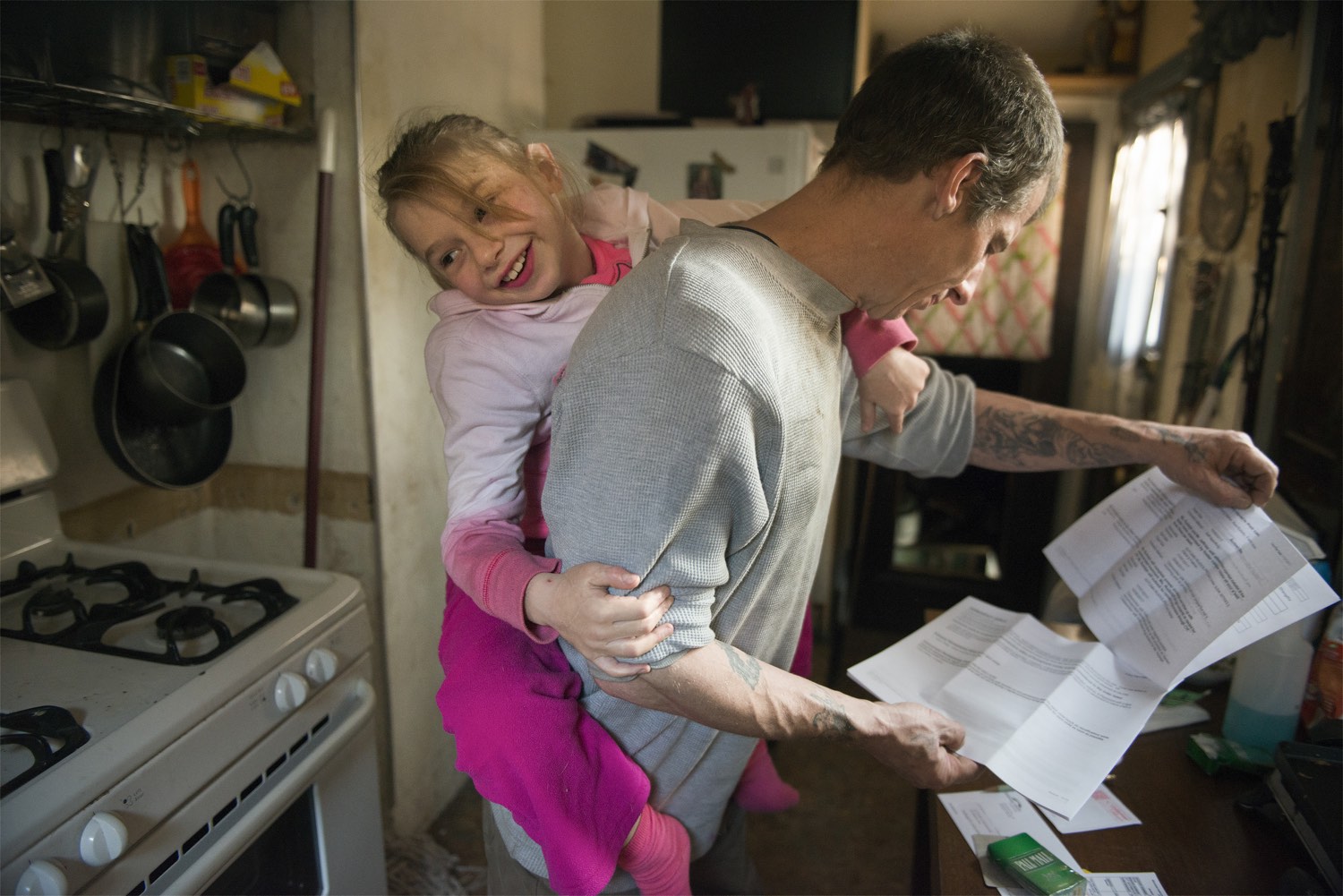
With daughter Cathy climbing on his back, Glenn Jeffries stands in his kitchen on Dec. 3 and reads a notification to appear in family court. Glenn returned to his Carrick home before completing a rehab program in late November, but said drugs were out of his system and that he and his partner Autumn Rudolph were no longer using opiates. (Steve Mellon/Post-Gazette)
Diane Dalton sorts through pictures of her daughter. (Stephanie Strasburg/Post-Gazette)
How do you help a daughter lost in a deep addiction? John had tried many ways. He’d stop by West Woodford to check on Jenn, he’d buy her food, cigarettes, water. Once he put her up in a hotel so she’d have a place to stay.
Still, he imagines what people think: Why didn’t John let his daughter stay at his house once she’d been released from jail?
“That works on me,” John said.
He’d watched dope destroy the daughter who, as a young child, often fell asleep in his lap. He’d witnessed the devastation of Jenn’s house and family. If he allowed his daughter to stay with him, John feared, he’d be welcoming dope into his home. “I’ve worked too hard to lose it all,” he said. “I felt bad that I didn’t do it, but I couldn’t do it.”
Still, he sometimes wonders, What would be different if I would have?
Diane Dalton first visited the desolate porch where her daughter’s body was discovered in mid-November. She carried plastic flowers, a battery-powered candle, a rock on which she’d painted Jenn’s name and dates of her birth and death, and a few other small items. Diane wanted to create a small memorial to her daughter, now three months gone.
After several moments on the back porch, Diane walked to the front of the house and sat cross-legged in the yard, in front of the wreath John had placed there shortly after Jenn’s death. Diane wept, but her grief was interrupted when a driver on Santron Avenue honked his horn.
White flakes danced down and settled on the ground. “That’s her bringing the snow,” Diane said. She placed a call to her aunt. “Hello? Hello?” Diane said. “Whenever you’re ready,” came the reply.
From a distant and warm place, Diane’s aunt began to sing, and a sweet rendition of the hymn “Amazing Grace” battled with the cold wind on Santron Avenue.
Video “Amazing Grace.”
Reporting & photography
Steve Mellon
smellon@post-gazette.com
Reporting & photography
Stephanie Strasburg
sstrasburg@post-gazette.com
Reporting
Rich Lord
rlord@post-gazette.com
Design, Development, Graphics Zack Tanner


